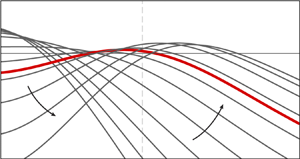Article contents
On the characteristics and mechanism of perturbation modes with asymptotic growth in trailing vortices
Published online by Cambridge University Press: 17 May 2021
Abstract

Trailing vortices typically persist into the extreme far-wake where the asymptotic perturbation dominates. In this work, we investigate the mechanism underlying the asymptotic growth of perturbation in trailing vortices by looking into the linear instabilities of two canonical trailing vortex systems, namely an isolated vortex and a co-rotating vortex pair with axial flow, generated by an M6 swept wing without/with winglets in a wind tunnel experiment. The dynamics and wandering phenomena of both vortex configurations are characterized by stereoscopic particle image velocimetry (SPIV). Their linear perturbation modes are acquired by local and bi-global linear stability analyses. For the isolated trailing vortex, the dominating perturbation mode is found to be a viscous, unstable Mode-A counter to the vortex rotation ( $m>0$), while Mode-A with
$m>0$), while Mode-A with  $m\leqslant 0$ is essentially damped and Mode-P, which is exclusive to
$m\leqslant 0$ is essentially damped and Mode-P, which is exclusive to  $|m|\leqslant 1$, remains marginally stable. For the co-rotating vortex pair, the upper vortex is subject to an unstable, azimuthal perturbation, while the dominating perturbation of the lower vortex is radial. The perturbation mode of the upper vortex is more unstable than that of the lower vortex. The difference is supported by the corresponding wandering amplitude. The dominating modes of the two vortex configurations manifest an identical feature of azimuthal perturbations penetrating the core boundary. The dominating mode overwhelms those centre modes confined within the core. For both vortex configurations, a limiting penetration depth exists, where the perturbation is most amplified asymptotically. The limiting penetration depth is ascribed to the alignment of the critical point with vortex shear. For the isolated vortex, it is the shear layer at the core boundary; for the vortex pair, it is the mutual shear layer of both vortices. The asymptotic growth of perturbations is thus attributed to an interaction between the respective characteristic layers of the perturbation and the flow at the leading order.
$|m|\leqslant 1$, remains marginally stable. For the co-rotating vortex pair, the upper vortex is subject to an unstable, azimuthal perturbation, while the dominating perturbation of the lower vortex is radial. The perturbation mode of the upper vortex is more unstable than that of the lower vortex. The difference is supported by the corresponding wandering amplitude. The dominating modes of the two vortex configurations manifest an identical feature of azimuthal perturbations penetrating the core boundary. The dominating mode overwhelms those centre modes confined within the core. For both vortex configurations, a limiting penetration depth exists, where the perturbation is most amplified asymptotically. The limiting penetration depth is ascribed to the alignment of the critical point with vortex shear. For the isolated vortex, it is the shear layer at the core boundary; for the vortex pair, it is the mutual shear layer of both vortices. The asymptotic growth of perturbations is thus attributed to an interaction between the respective characteristic layers of the perturbation and the flow at the leading order.
JFM classification
Information
- Type
- JFM Papers
- Information
- Copyright
- © The Author(s), 2021. Published by Cambridge University Press
References
REFERENCES
- 9
- Cited by


